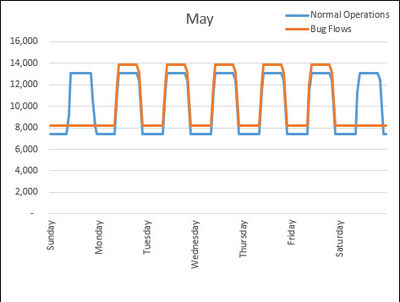Difference between revisions of "The Bugflow Experiment"
Cellsworth (Talk | contribs) |
Cellsworth (Talk | contribs) |
||
| Line 18: | Line 18: | ||
[[File:BugflowHydrograph.jpg|400px]] <br> | [[File:BugflowHydrograph.jpg|400px]] <br> | ||
| − | Example | + | Example of an experimental Macroinvertebrate Production Flow (MPF) hydrograph |
<!-- | <!-- | ||
| Line 25: | Line 25: | ||
|style="width:60%; font-size:120%;"| | |style="width:60%; font-size:120%;"| | ||
| − | '''What is the | + | '''What is the “Macroinvertebrate Production Flow (MPF)" experiment?''' <br> |
| − | This would be an experimental release at Glen Canyon Dam to see if short-duration steady flow might increase the diversity and production of aquatic insects below Glen Canyon Dam. This experiment is included in the Preferred Alternative of the [http://gcdamp.com/index.php?title=Long-term_Experimental_and_Management_Plan_(LTEMP) LTEMP DEIS]. These | + | This would be an experimental release at Glen Canyon Dam to see if short-duration steady flow might increase the diversity and production of aquatic insects below Glen Canyon Dam. This experiment is included in the Preferred Alternative of the [http://gcdamp.com/index.php?title=Long-term_Experimental_and_Management_Plan_(LTEMP) LTEMP DEIS]. These “macroinvertebrate production flows” would occur from May to August and would maintain releases on the weekends to a level equal to the minimum release made during the week. This would allow aquatic insects two days a week throughout the river corridor to be able to lay their eggs at a stage where they would not be at risk of being dewatered or desiccated. The experiment would include monitoring to evaluate if the flows did increase the diversity and production of aquatic insects. The experiment was designed to test the hypothesis put forward in [[Media:Kennedy 2016 HydropowerEPT.pdf| '''Kennedy's 2016 BioScience Paper''']] while minimizing impacts to the hydropower resource at Glen Canyon Dam by having the steady flows on the weekend. This results in a transfer of water from the weekend to the weekdays increasing the daily minimums and maximums and the range of fluctuation during the week. Western believes that this experiment will result in only a small decrease in the energy value, but a modest increase in the capacity value of hydropower produced at Glen Canyon Dam. |
|}<!-- | |}<!-- | ||
| Line 45: | Line 45: | ||
Modeling Assumptions: | Modeling Assumptions: | ||
| − | * | + | *Macroinvertebrate Production Flows (MPFs) would occur every weekend from May - Aug (34 days, we scheduled July to have the 5th weekend because that how it works out in 2016) |
*Weekend flow = minimum flow for the month = weekday minimum flow (see weekly hydrographs on the monthly tabs) | *Weekend flow = minimum flow for the month = weekday minimum flow (see weekly hydrographs on the monthly tabs) | ||
*Hybrid Public Draft monthly volume, ramp rates, or daily change parameters | *Hybrid Public Draft monthly volume, ramp rates, or daily change parameters | ||
| Line 89: | Line 89: | ||
|style="color:#000;"| | |style="color:#000;"| | ||
| − | [http://gcdamp.com/index.php?title=The_Bugflow_Experiment '''Low steady weekend flows ( | + | [http://gcdamp.com/index.php?title=The_Bugflow_Experiment '''Low steady weekend flows (“Macroinvertebrate Production Flows”)'''] would be conducted to test whether the |
flows would increase insect abundance. On an experimental basis, for example, | flows would increase insect abundance. On an experimental basis, for example, | ||
flows would be held low and steady for two days per week (weekends) from May | flows would be held low and steady for two days per week (weekends) from May | ||
Revision as of 10:06, 22 August 2017
|
|
What is the “Macroinvertebrate Production Flow (MPF)" experiment? |
| --- |
--- |
--- |
|---|
|
|
